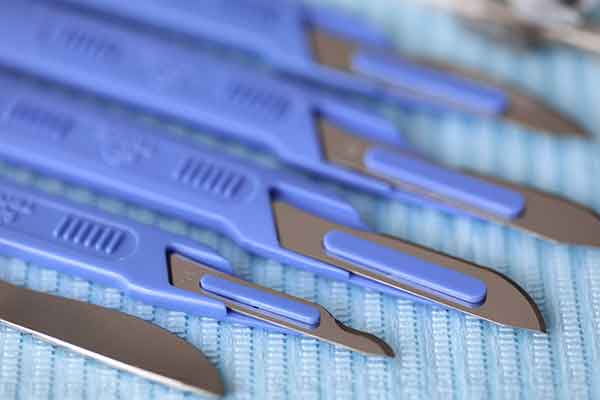In hospitals, much is demanded of medical plastics. They must be safe, durable, comfortable to handle and cost effective. They must also be compatible with the hospital’s sterilization methods, which the hospital defines.
Sterilizing processes are harsh, and it’s critical that hospitals know which medical plastics can best withstand each method. Also importantly, some medical plastics can tolerate more sterilization cycles than others. When comparing rigid thermoplastics for sterilizable devices, longevity relative to their practical use is an important factor. Very often, a material with a higher initial cost may provide a significant increase in the number of sterilization cycles. In such cases, the higher material cost is well worth the investment when spread over a longer useful life for the device. Conversely, matching the wrong sterilization method to a medical plastic can also degrade the material and cause the device or instrument to fail early.
This guide describes the more common sterilization methods and summarizes which rigid, medical grade plastics demonstrate the highest levels of compatibility and longevity when subjected to each of the methods. The intent is to assist medical device manufacturers in sourcing the right plastics, using sterilization compatibility and the ability to retain properties after multiple sterilization cycles as the primary considerations.
What Are the Common Sterilization Methods and How Can They Affect Medical Plastics?
Sterilization is a straightforward concept for hospitals. There are only a handful of sterilization methods in widespread use among medical facilities, and there are medical plastics best suited to each of them, all with different degrees of longevity. Among those processes, a few of the most common include:
Steam Sterilization

Sterilization via saturated steam is one of the most common and dependable forms of sterilization. Executed with the use of an autoclave, steam sterilization requires precise temperature, pressure, and water saturation levels to work. Heat is what degrades microorganisms in this instance.
Autoclaves are typically set to either 121o C (250o F) or 132o C (270o F). Time is also a factor. At 121o C, it takes 30 minutes to complete sterilization. At 132o C, only four minutes is required.
In both instances, though, the extreme heat and pressure can damage some medical grade plastics and cause significant degradation of the material’s physical properties, most notably to its toughness and impact resistance.
Which medical grade plastics perform best in steam sterilization?
Rigid medical grade plastics with the highest levels of longevity in steam sterilization at both 250oF/121oC and 273oF/134oC are PEEK, Radel® PPSU, Ultem PEI and PP-H (polypropylene homopolymer).
Udel® PSU (polysulfone) and POM-C (acetal copolymer) also demonstrate good life at the lower of the two sterilization temperatures.
Chemical Sterilization
Several methods fall under the chemical sterilization umbrella. Two of the most common involve the use of either ethylene oxide gas or hydrogen peroxide gas. Here’s a closer look at each:
Ethylene Oxide Gas Sterilization
Ethylene oxide is a colorless, flammable, and potentially toxic gas that is also a highly effective antimicrobial agent. During sterilization, the material is placed in an airtight chamber that is conditioned and humidified. The ethylene oxide gas is then introduced into the chamber. After about two hours of exposure, the gas is removed, and the material is aerated for several more hours to release any trapped gas.
Although ethylene oxide is harmful to people, it’s safe for use with heat or moisture-sensitive materials in a controlled environment where it is not released. As such, it’s common for ethylene oxide sterilization to be used with instruments and devices made from materials that cannot withstand a number of steam sterilization cycles.
Which medical grade plastics are most compatible with ethylene oxide sterilization?
PEEK, Radel PPSU, and Ultem PEI are recognized as having the highest level of tolerance to multiple sterilization cycles in ETO.
Hydrogen Peroxide Gas Sterilization
Hydrogen peroxide gas sterilization has been in use since the early 1990s. During the process, a gas plasma is created inside a vacuum chamber through the application of radio waves or microwaves. This plasma excites gas particles and creates charged particles that react with and destroy microbes.
Hydrogen peroxide gas sterilization is safer than using ethylene oxide gas, as its byproducts (water and oxygen) are nontoxic. As such, it’s considered an emerging alternative to ethylene oxide sterilization, even if it is not compatible with all materials. Heavy absorbers like paper and cotton, for example, cannot be sterilized using hydrogen peroxide plasma.
Which medical plastics best withstand hydrogen peroxide gas sterilization?
PEEK, PAEK, Ixef PARA, Udel PSU, Radel PPSU and Ultem PEI perform well over many cycles using this sterilization method. Some color shifting is expected, but strength and modulus are unaffected by hydrogen peroxide gas in the process.
Gamma Radiation
Gamma irradiation is a comprehensive sterilization process that has excellent penetrability when used with polymer materials. The process utilizes cobalt-60 to generate gamma rays, which destroy microbes at the genetic level.
Gamma radiation sterilization is extremely efficient and can be used to sterilize large instrument batches at once. However, it is not appropriate for all medical grade plastics.
Which medical plastics are most resistant to the effects of gamma radiation?
High performance polymers like PEEK, Ixef PARA, Ultem PEI and Radel PPSU remain stable after hundreds of gamma cycles.
It should be noted that gamma radiation can affect the structural properties and elasticity or impact resistance of POM and PC and these effects are cumulative.
